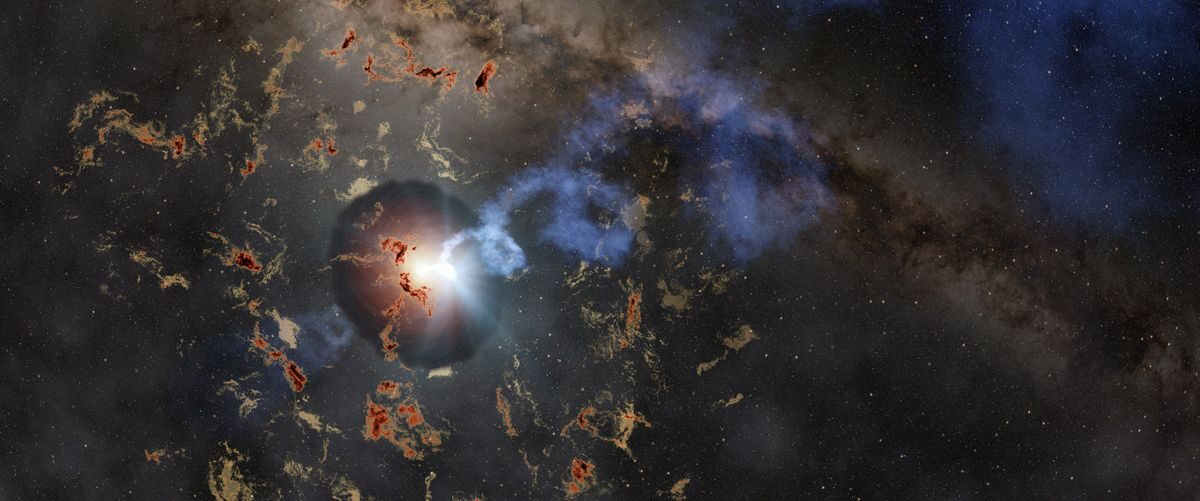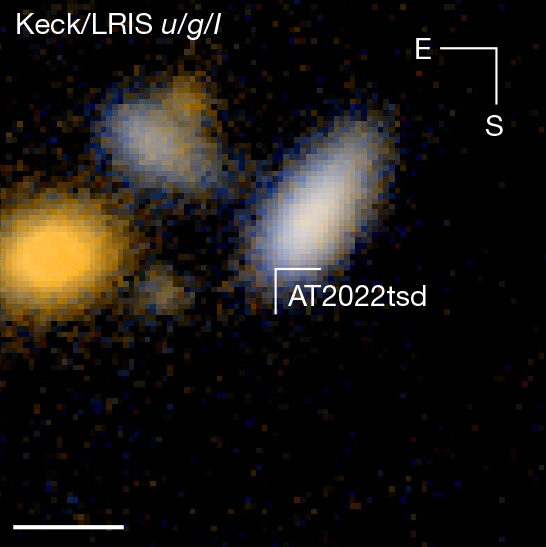
The system designated the event AT2022tsd, but it some came to be called the "Tasmanian Devil." It joined the short list of a special class of objects discovered in 2018 known as luminous fast blue optical transients (LFBOTs). Astronomers think these explosive flares are a special kind of supernova, but they could also be stars ripped apart in the intense gravitational field surrounding a neutron star or black hole. The devil, as they say, is in the details.
But while the Tasmanian Devil's discovery was a welcome surprise, the real bombshell came 100 days later. In December that year, Anna Ho (Cornell University) and colleagues were reviewing routine images that had monitored the fading flare when, to their bewilderment, they found a red-colored burst almost as bright as the original blue one, and in the same position on the sky.
Scouring for more data, both in the archive and then with new observations, the astronomers found another outburst — and then another, and another. The energy of each one of these outbursts is equivalent to that released from an exploding star. Overall, at least 14 flares followed the first one, Ho and colleagues report in Nature, and it's likely there were many more they missed.
"An event like this has never been witnessed before," says team member Jeff Cooke (Swinburne University of Technology and the ARC Centre of Excellence in Gravitational Wave Discovery, Australia).
"Indeed, optical flares following an explosive transient like the Tasmanian Devil — with luminosity similar to supernovae, but only lasting a minute or two — are a completely new (and unexpected) discovery," agrees Ashley Chrimes (ESA), who wasn't involved with the study.

Zwicky picked up the rapidly fading Tasmanian Devil within about an arcsecond of a galaxy 3 billion light-years away. That alignment was fortunate for astronomers, since it lends a distance to the flare that would otherwise be unknown.
Follow-up observations showed that, while the blue light faded quickly, the source also gave off bright radio and X-ray emission for weeks afterward. While the initial, blue light was likely thermal in nature, meaning that it comes from the heat of the explosion, the radio waves and X-rays, as well as the subsequent, red-colored flares, likely come not from heat but from something else. Most likely, the emission comes from speedy electrons whizzing around strong magnetic fields.
In fact, the follow-on flares brighten and fade so quickly — within minutes at the longest, and some flares are as short as 20 seconds — that whatever source they come from is correspondingly tiny. (A source can only brighten or fade as fast as light can travel across it, so quick changes indicate a smaller size.) The source of the flares is no more than 10 times the width of the Sun, Ho's team finds.
The nature of the emission together with the small size and extreme energies suggests that the flares are coming from a jet that's escaping the gravity of a black hole or neutron star at near-light speeds.
"The result supports theories for LFBOTs which involve a neutron star or black hole accreting mass — not just initially (causing the explosion) — but also at a lower level for many months or even years afterwards," Chrimes says.
That still leaves a lot of possibilities for what causes LFBOTs to begin with. Ho and colleagues consider three scenarios to be likely: the collapse of a super-giant star, the merger of a massive star with a neutron star or black hole, or the white-dwarf meal of a black hole hundreds or thousands of times the Sun's mass. All three of these scenarios could produce a speedy jet of escaping material.
"The [stellar] corpse is not just sitting there," Ho says, "it's active and doing things that we can detect." The Tasmanian Devil thus provides astronomers with a new way to study these celestial explosions, and perhaps ultimately find out what is creating them.



Reader Comments
The polarity reversal will also affect the planets, flipping them over, maintaining spin momentum. They will expand and then contract as the new AC powers on.
The Bethlehem Star is the timer...Dec 2020. The countdown has begun!